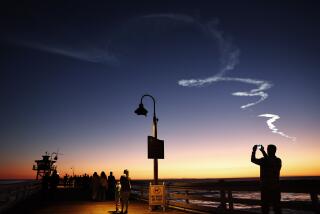Astronomers spot aftermath of asteroid collision
An object imaged last week by the Hubble Space Telescope looks at first glance to be a comet, but a closer examination indicates it is something researchers have never seen before -- the immediate aftermath of two asteroids colliding.
The scattered debris that looks like a comet’s tail is actually the result of two asteroids colliding nearly head-on at more than 11,000 miles per hour, scattering pieces in all directions, NASA announced Tuesday. The asteroid belt between Mars and Jupiter, where the collision occurred, contains the remains of many such events from the distant past, but this is first time that researchers have observed such debris so soon after a collision.
The object, called P/2010 A2, was first observed Jan. 6 by the Lincoln Near-Earth Asteroid Research program, and astronomers thought it was a comet. But images taken by Hubble on Jan. 25 and 29 show something far different.
Comets are icy bodies that fall into the inner solar system from distant reservoirs in the Kuiper Belt and Oort Cloud. As they warm up, they shed particles and water vapor that are pushed away from the comet in a smooth tail by solar pressure.
But spectra of P/2010 A2 show no gases associated with the object, indicating there is no water present. The main body of the object, which is about 460 feet in diameter, lies separate from the “tail,” and the tail itself shows an unusual filamentous structure that includes a large X-shaped portion.
The most likely explanation, said principal investigator David Jewitt of UCLA, is that two small and previously unknown asteroids recently collided, creating a shower of debris that is being swept back into a tail from the collision site by the presence of sunlight.
Based on the length of the tail, about 100,000 miles, the collision probably happened just a few months ago, Jewitt said.
The orbit of the object suggests that it is part of the Flora asteroid family, a group produced by other collisions more than 100 million years ago. One former member of the family is thought to be the asteroid that struck Earth 65 million years ago, creating a global cooling that caused dinosaurs to become extinct.
When observed by Hubble, P/2010 A2 was about 180 million miles from the sun and 90 million miles from Earth.
In addition to the image being “a super-cool thing to look at,” Jewitt said, “it will help us understand the physics of the breakup of a body in space. That’s almost unexplored, but it is something we want to know about” because of the likelihood that a large asteroid will eventually approach Earth and need to be destroyed.






